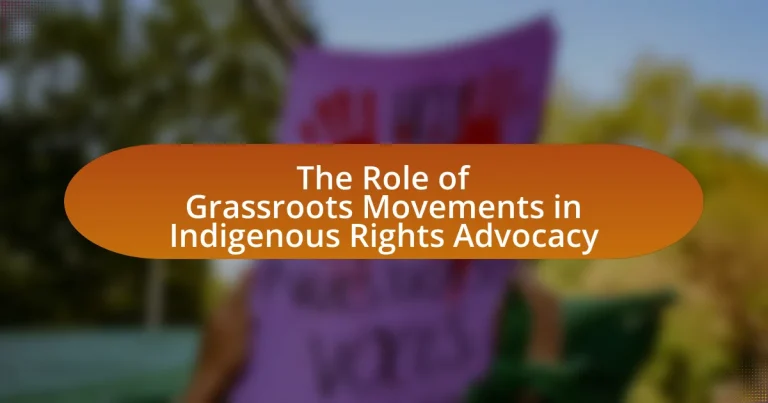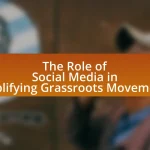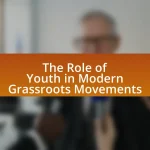Grassroots movements in Indigenous rights advocacy are community-driven initiatives focused on promoting and protecting the rights of Indigenous peoples, addressing issues such as land rights, cultural preservation, and social justice. These movements emerge from collective action within Indigenous communities, often in response to systemic injustices and external pressures. Key factors contributing to their formation include social injustice, cultural preservation, and political mobilization, with strategies such as community organizing, coalition building, and direct action being employed to influence policy changes. Grassroots movements play a crucial role in shaping public perception, fostering solidarity, and challenging systemic barriers, ultimately leading to significant advancements in Indigenous rights and advocacy efforts.

What are Grassroots Movements in Indigenous Rights Advocacy?
Grassroots movements in Indigenous rights advocacy are community-driven efforts aimed at promoting and protecting the rights of Indigenous peoples. These movements often emerge from local communities and focus on issues such as land rights, cultural preservation, and social justice. For instance, the Standing Rock Sioux Tribe’s protest against the Dakota Access Pipeline in 2016 exemplifies a grassroots movement that mobilized widespread support to advocate for Indigenous sovereignty and environmental protection. Such movements are characterized by their reliance on local knowledge, direct action, and the active participation of community members, which enhances their legitimacy and effectiveness in challenging systemic injustices faced by Indigenous populations.
How do grassroots movements emerge within Indigenous communities?
Grassroots movements within Indigenous communities emerge primarily through collective action driven by shared cultural values, social injustices, and the need for self-determination. These movements often arise in response to external pressures such as land dispossession, environmental degradation, and systemic discrimination, which galvanize community members to unite for their rights. Historical examples include the American Indian Movement in the 1960s and 1970s, which mobilized Indigenous people across the United States to advocate for sovereignty and civil rights, highlighting the effectiveness of grassroots organizing in addressing grievances and asserting identity.
What factors contribute to the formation of these movements?
Factors contributing to the formation of grassroots movements in Indigenous rights advocacy include social injustice, cultural preservation, and political mobilization. Social injustice arises from systemic discrimination and marginalization faced by Indigenous communities, prompting collective action to address grievances. Cultural preservation is driven by the desire to protect and promote Indigenous identities, languages, and traditions, which are often threatened by external forces. Political mobilization occurs as communities seek to influence policy decisions and gain recognition of their rights, often leveraging social media and community organizing to amplify their voices. These factors collectively create a fertile ground for grassroots movements to emerge and thrive, as evidenced by numerous successful campaigns advocating for land rights and environmental protection in various regions.
How do cultural traditions influence grassroots activism?
Cultural traditions significantly influence grassroots activism by shaping the values, beliefs, and practices that motivate community engagement and collective action. For instance, in many Indigenous communities, cultural traditions emphasize communal decision-making and respect for ancestral lands, which directly informs their activism strategies. Research shows that grassroots movements rooted in cultural identity often mobilize more effectively, as seen in the Standing Rock protests against the Dakota Access Pipeline, where traditional practices and community gatherings galvanized widespread support and participation. This connection between cultural heritage and activism not only strengthens community bonds but also enhances the legitimacy and resonance of their demands in broader social and political contexts.
Why are grassroots movements essential for Indigenous rights?
Grassroots movements are essential for Indigenous rights because they empower communities to advocate for their own interests and amplify their voices in the political arena. These movements often arise from local experiences and cultural contexts, allowing Indigenous peoples to address specific issues such as land rights, cultural preservation, and social justice. For instance, the Idle No More movement in Canada mobilized Indigenous communities to protest against government policies that threatened their rights and lands, demonstrating the effectiveness of grassroots organizing in achieving policy change. Additionally, grassroots movements foster solidarity among Indigenous groups and allies, creating a collective force that can challenge systemic injustices and promote Indigenous sovereignty.
What unique perspectives do grassroots movements bring to advocacy?
Grassroots movements bring localized knowledge and community-driven insights to advocacy, which enhances the effectiveness of campaigns. These movements often emerge from the direct experiences and needs of marginalized groups, allowing them to articulate specific issues that may be overlooked by larger organizations. For instance, grassroots movements in Indigenous rights advocacy have successfully highlighted the importance of cultural preservation and land sovereignty, which are critical to the identity and survival of Indigenous communities. Research shows that grassroots efforts can mobilize community members more effectively, as seen in the Standing Rock protests against the Dakota Access Pipeline, where local voices played a pivotal role in raising awareness and influencing public opinion.
How do these movements challenge systemic injustices?
Grassroots movements challenge systemic injustices by mobilizing communities to advocate for their rights and demand accountability from institutions. These movements often highlight the disparities faced by marginalized groups, such as Indigenous peoples, and work to dismantle oppressive structures through direct action, education, and policy reform. For instance, the Standing Rock protests against the Dakota Access Pipeline brought national attention to Indigenous sovereignty and environmental justice, illustrating how grassroots activism can disrupt corporate and governmental practices that perpetuate inequality. By fostering solidarity and raising awareness, these movements empower individuals to confront systemic barriers and push for equitable change.
What strategies do grassroots movements employ in their advocacy?
Grassroots movements employ strategies such as community organizing, coalition building, and direct action in their advocacy efforts. Community organizing involves mobilizing local individuals to raise awareness and address issues affecting their communities, which fosters a sense of ownership and empowerment. Coalition building brings together diverse groups to amplify their voices and resources, enhancing their collective impact. Direct action, including protests and demonstrations, serves to draw public attention to specific injustices and pressure decision-makers for change. These strategies have been effective in various contexts, such as the Standing Rock protests against the Dakota Access Pipeline, where grassroots mobilization successfully highlighted indigenous rights and environmental concerns.
How do grassroots movements utilize social media for awareness?
Grassroots movements utilize social media to raise awareness by creating platforms for dialogue, sharing information rapidly, and mobilizing supporters. These movements leverage social media’s wide reach to disseminate messages about indigenous rights, often using hashtags to unify their campaigns and increase visibility. For example, the #NoDAPL movement against the Dakota Access Pipeline effectively utilized Twitter and Facebook to inform the public about environmental and indigenous rights issues, garnering international attention and support. This strategic use of social media not only amplifies their message but also fosters community engagement and solidarity among diverse groups, demonstrating the power of digital platforms in contemporary advocacy efforts.
What role do community organizing and mobilization play?
Community organizing and mobilization play a crucial role in empowering Indigenous communities to advocate for their rights and interests. These processes facilitate collective action, enabling individuals to unite around common goals, such as land rights, cultural preservation, and social justice. Historical examples, such as the American Indian Movement in the 1960s and 1970s, demonstrate how organized efforts can lead to significant policy changes and increased visibility for Indigenous issues. Mobilization efforts often result in stronger community networks, enhanced political engagement, and the ability to challenge systemic injustices effectively.
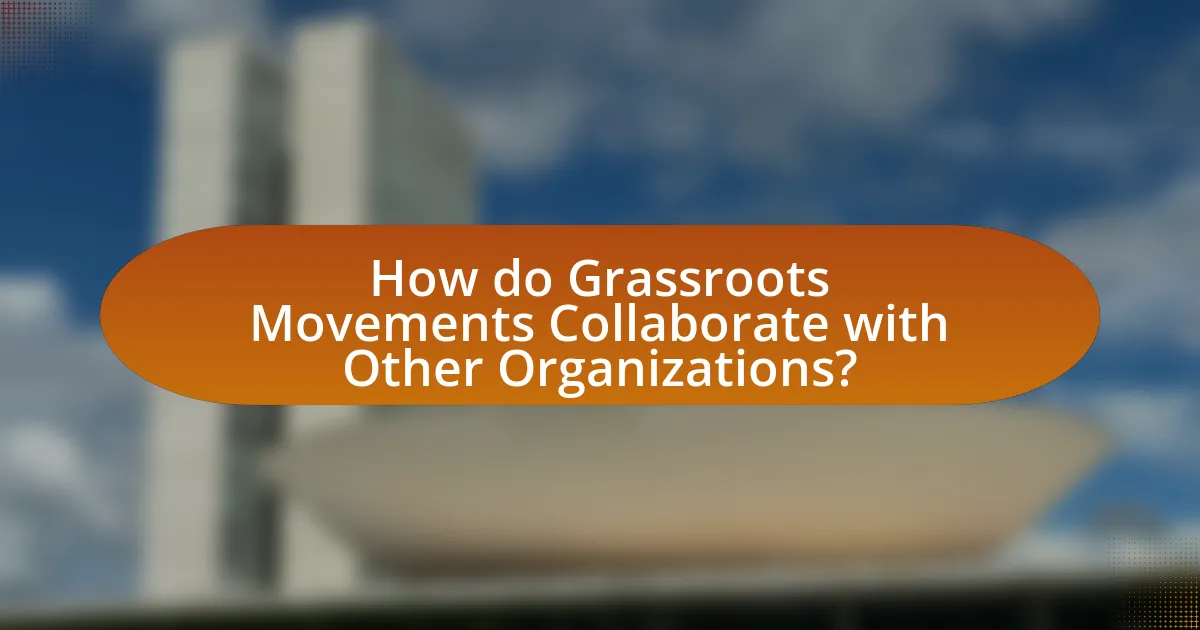
How do Grassroots Movements Collaborate with Other Organizations?
Grassroots movements collaborate with other organizations through strategic partnerships, resource sharing, and joint campaigns to amplify their advocacy efforts. These collaborations often involve aligning goals and objectives, which enhances the visibility and impact of both grassroots initiatives and established organizations. For instance, grassroots movements may partner with NGOs or community groups to leverage funding, expertise, and networks, thereby increasing their capacity to address indigenous rights issues effectively. A notable example is the collaboration between grassroots organizations and larger advocacy groups during the Standing Rock protests, where collective efforts drew international attention to indigenous rights and environmental concerns. This synergy not only strengthens the grassroots movements but also enriches the broader advocacy landscape by fostering solidarity and shared objectives.
What partnerships are formed between grassroots movements and NGOs?
Grassroots movements often form strategic partnerships with NGOs to amplify their advocacy efforts for indigenous rights. These collaborations typically involve resource sharing, capacity building, and joint campaigns that leverage the strengths of both entities. For instance, grassroots movements provide local knowledge and community engagement, while NGOs contribute funding, technical expertise, and broader networks. A notable example is the partnership between the Indigenous Environmental Network and various environmental NGOs, which has successfully mobilized support for indigenous land rights and environmental justice initiatives. Such partnerships enhance visibility and impact, as evidenced by the increased media attention and policy influence achieved through coordinated efforts.
How do these collaborations enhance advocacy efforts?
Collaborations enhance advocacy efforts by pooling resources, expertise, and networks among various stakeholders, which amplifies the reach and impact of advocacy initiatives. For instance, when grassroots movements partner with established organizations, they gain access to funding, training, and broader platforms to voice their concerns, thereby increasing visibility for indigenous rights issues. Research indicates that collaborative efforts can lead to more effective campaigns, as seen in the 2019 United Nations Permanent Forum on Indigenous Issues, where joint advocacy by multiple groups resulted in significant policy discussions on indigenous rights.
What challenges arise in these partnerships?
Challenges in partnerships between grassroots movements and Indigenous rights advocacy include differing priorities, resource limitations, and cultural misunderstandings. Grassroots movements may prioritize immediate social issues, while Indigenous groups often focus on long-term sovereignty and cultural preservation. Resource limitations can hinder effective collaboration, as many grassroots organizations operate on tight budgets and may lack the necessary funding to support Indigenous initiatives. Cultural misunderstandings can arise from differing communication styles and values, leading to conflicts or misalignment in goals. These challenges can impede the effectiveness of advocacy efforts and require careful navigation to foster successful partnerships.
How do grassroots movements engage with governmental bodies?
Grassroots movements engage with governmental bodies primarily through advocacy, lobbying, and public campaigns aimed at influencing policy decisions. These movements often mobilize community members to raise awareness about specific issues, such as indigenous rights, and present their demands to government officials. For instance, the Idle No More movement in Canada effectively utilized social media and public demonstrations to pressure the government to recognize and uphold indigenous treaty rights, leading to increased dialogue between indigenous leaders and policymakers. This engagement is often characterized by direct communication, participation in public consultations, and collaboration with other organizations to amplify their voices and demands.
What strategies do they use to influence policy changes?
Grassroots movements influence policy changes through strategies such as mobilizing community engagement, leveraging social media for awareness, and forming coalitions with other advocacy groups. These movements often organize protests and public demonstrations to draw attention to specific issues, thereby pressuring policymakers to take action. For instance, the Standing Rock Sioux Tribe’s protests against the Dakota Access Pipeline in 2016 galvanized national attention and led to temporary halts in construction, showcasing the power of grassroots activism. Additionally, grassroots organizations frequently utilize storytelling and personal testimonies to humanize their causes, making it easier for the public and lawmakers to connect with the issues at hand.
How effective are these engagements in achieving Indigenous rights?
Grassroots movements are highly effective in achieving Indigenous rights, as they mobilize communities, raise awareness, and influence policy changes. For instance, the Idle No More movement in Canada successfully brought attention to Indigenous issues, leading to increased dialogue with government officials and the implementation of policy reforms. Additionally, grassroots advocacy has resulted in legal victories, such as the recognition of land rights in various court cases, demonstrating the tangible impact these engagements have on advancing Indigenous rights.
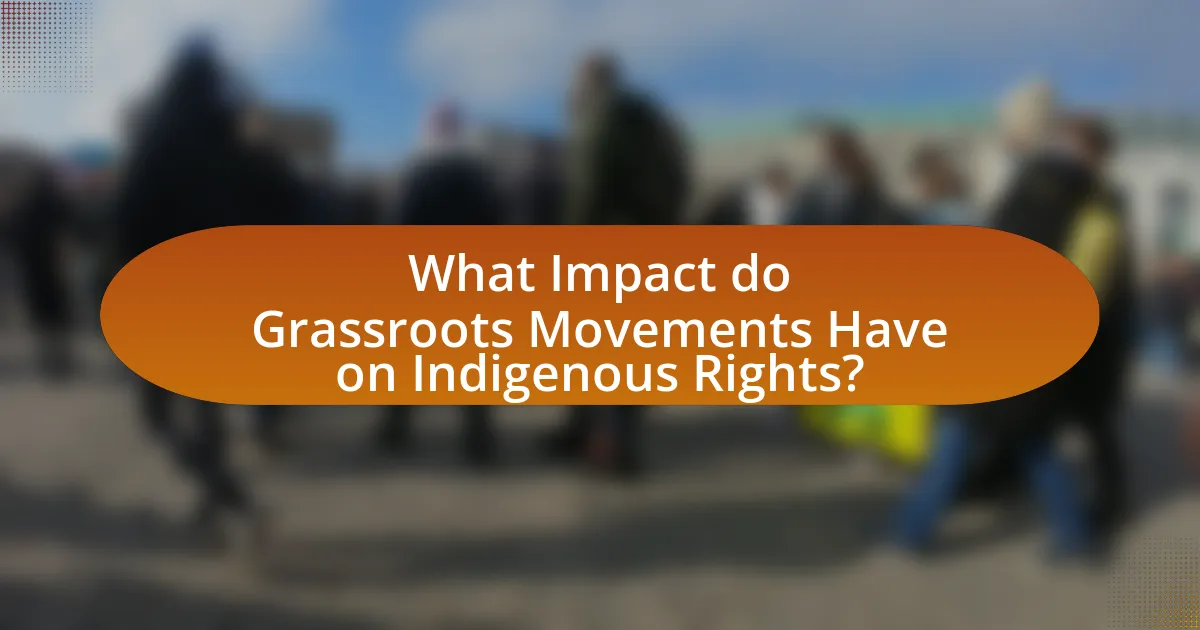
What Impact do Grassroots Movements Have on Indigenous Rights?
Grassroots movements significantly enhance Indigenous rights by mobilizing communities, raising awareness, and influencing policy changes. These movements often serve as platforms for Indigenous voices, allowing them to advocate for land rights, cultural preservation, and self-determination. For instance, the Standing Rock Sioux Tribe’s protest against the Dakota Access Pipeline in 2016 galvanized international support and highlighted the importance of Indigenous sovereignty over ancestral lands. This mobilization led to increased media attention and legislative discussions regarding Indigenous rights, demonstrating the tangible impact grassroots efforts can have on policy and public perception.
How do grassroots movements influence public perception of Indigenous issues?
Grassroots movements significantly influence public perception of Indigenous issues by raising awareness and mobilizing community support. These movements often utilize social media campaigns, public demonstrations, and educational initiatives to highlight the challenges faced by Indigenous communities, such as land rights, cultural preservation, and social justice. For instance, the Idle No More movement in Canada effectively brought attention to Indigenous rights and environmental concerns, leading to increased public discourse and policy discussions. Research indicates that grassroots activism can shift public attitudes, as seen in surveys showing heightened awareness and support for Indigenous issues following prominent grassroots campaigns.
What role does storytelling play in shaping narratives?
Storytelling plays a crucial role in shaping narratives by providing a framework through which experiences, values, and cultural identities are communicated. In the context of grassroots movements for Indigenous rights, storytelling serves as a powerful tool for advocacy, allowing communities to share their histories, struggles, and aspirations. This method not only fosters a sense of belonging and solidarity among Indigenous peoples but also educates broader audiences about their rights and issues. Research indicates that narratives rooted in personal and collective experiences can significantly influence public perception and policy decisions, as seen in movements like the Standing Rock protests against the Dakota Access Pipeline, where storytelling was integral to mobilizing support and raising awareness.
How do grassroots movements mobilize public support?
Grassroots movements mobilize public support by fostering community engagement and leveraging social networks. These movements often utilize local leaders and activists to raise awareness about specific issues, creating a sense of urgency and collective identity among participants. For example, the Standing Rock protests against the Dakota Access Pipeline in 2016 galvanized widespread support through social media campaigns, which highlighted the environmental and cultural impacts on Indigenous lands. This mobilization was further supported by the participation of diverse groups, including environmentalists and human rights advocates, demonstrating the effectiveness of coalition-building in amplifying their message.
What measurable outcomes have resulted from grassroots advocacy?
Grassroots advocacy has led to significant measurable outcomes, including policy changes, increased funding for Indigenous programs, and enhanced community engagement. For instance, the Idle No More movement in Canada successfully influenced the government to amend legislation affecting Indigenous rights, resulting in the introduction of Bill C-45, which was met with widespread opposition and ultimately led to a more inclusive consultation process. Additionally, grassroots campaigns have secured millions in funding for health and education initiatives, demonstrating a direct impact on resource allocation. Furthermore, these movements have fostered greater awareness and participation among Indigenous communities, as evidenced by increased voter turnout in local elections following advocacy efforts.
How have specific policies changed due to grassroots efforts?
Grassroots efforts have led to significant changes in policies regarding Indigenous rights, particularly through increased advocacy for land rights and self-determination. For example, the Idle No More movement in Canada mobilized public support and pressured the government to amend legislation affecting Indigenous land and resource management, resulting in the introduction of the First Nations Financial Transparency Act in 2013. This act aimed to enhance accountability and transparency in First Nations governance, reflecting the demands of grassroots activists for greater autonomy and recognition of Indigenous rights. Additionally, grassroots campaigns have influenced the United Nations Declaration on the Rights of Indigenous Peoples, which was adopted in 2007, showcasing how local movements can drive international policy changes.
What successes can be attributed to grassroots movements in recent years?
Grassroots movements have successfully raised awareness and advanced policies related to Indigenous rights in recent years. For instance, the #LandBack movement has gained significant traction, leading to the return of ancestral lands to Indigenous communities in various regions, such as the return of the San Francisco Peaks to the Navajo Nation in Arizona. Additionally, grassroots campaigns have influenced legislation, exemplified by the passage of the Indian Child Welfare Act amendments in 2021, which strengthened protections for Indigenous children. These successes demonstrate the effectiveness of grassroots advocacy in achieving tangible outcomes for Indigenous rights.
What are the future challenges for grassroots movements in Indigenous rights advocacy?
Future challenges for grassroots movements in Indigenous rights advocacy include increasing governmental resistance, resource limitations, and the need for broader coalition-building. Governments often implement policies that undermine Indigenous rights, as seen in cases where land rights are contested or environmental regulations are weakened. Additionally, grassroots movements frequently face funding shortages, which can hinder their ability to mobilize and sustain campaigns. The necessity for forming alliances with other social justice movements is critical, as collaboration can amplify voices and strengthen advocacy efforts, yet achieving unity among diverse groups presents its own challenges.
How can grassroots movements adapt to changing political landscapes?
Grassroots movements can adapt to changing political landscapes by employing flexible strategies that respond to shifts in public sentiment and policy. These movements often engage in continuous dialogue with their communities to understand evolving needs and concerns, allowing them to adjust their messaging and tactics accordingly. For instance, during the 2016 Standing Rock protests, Indigenous activists utilized social media to mobilize support and raise awareness, demonstrating adaptability in their communication methods in response to the political climate surrounding pipeline construction. This approach not only amplified their message but also attracted a diverse coalition of supporters, showcasing the effectiveness of grassroots movements in navigating complex political environments.
What strategies can ensure sustainability and growth of these movements?
To ensure sustainability and growth of grassroots movements in Indigenous rights advocacy, establishing strong community engagement and building coalitions are essential strategies. Strong community engagement fosters trust and participation, which are critical for mobilizing support and resources. For instance, the Dakota Access Pipeline protests in 2016 demonstrated how local communities united to advocate for Indigenous rights, leading to widespread national attention and support. Building coalitions with other organizations amplifies voices and resources, as seen in the collaboration between Indigenous groups and environmental organizations, which enhances advocacy efforts and broadens the movement’s impact. These strategies create a resilient framework that can adapt to challenges and sustain momentum over time.
